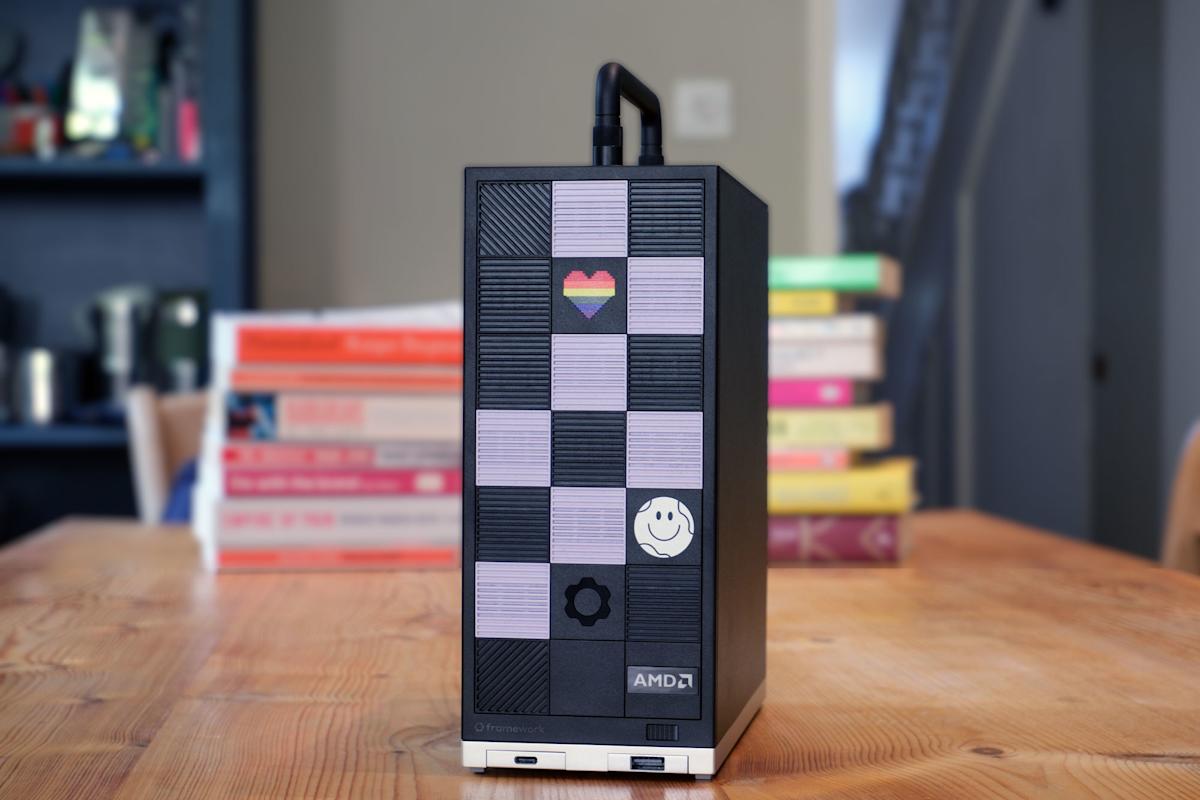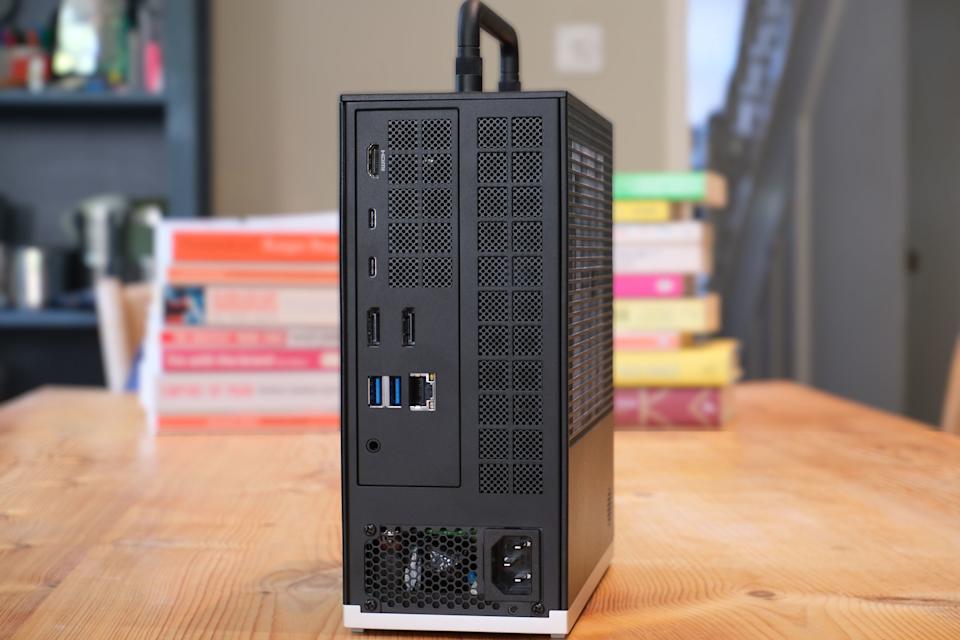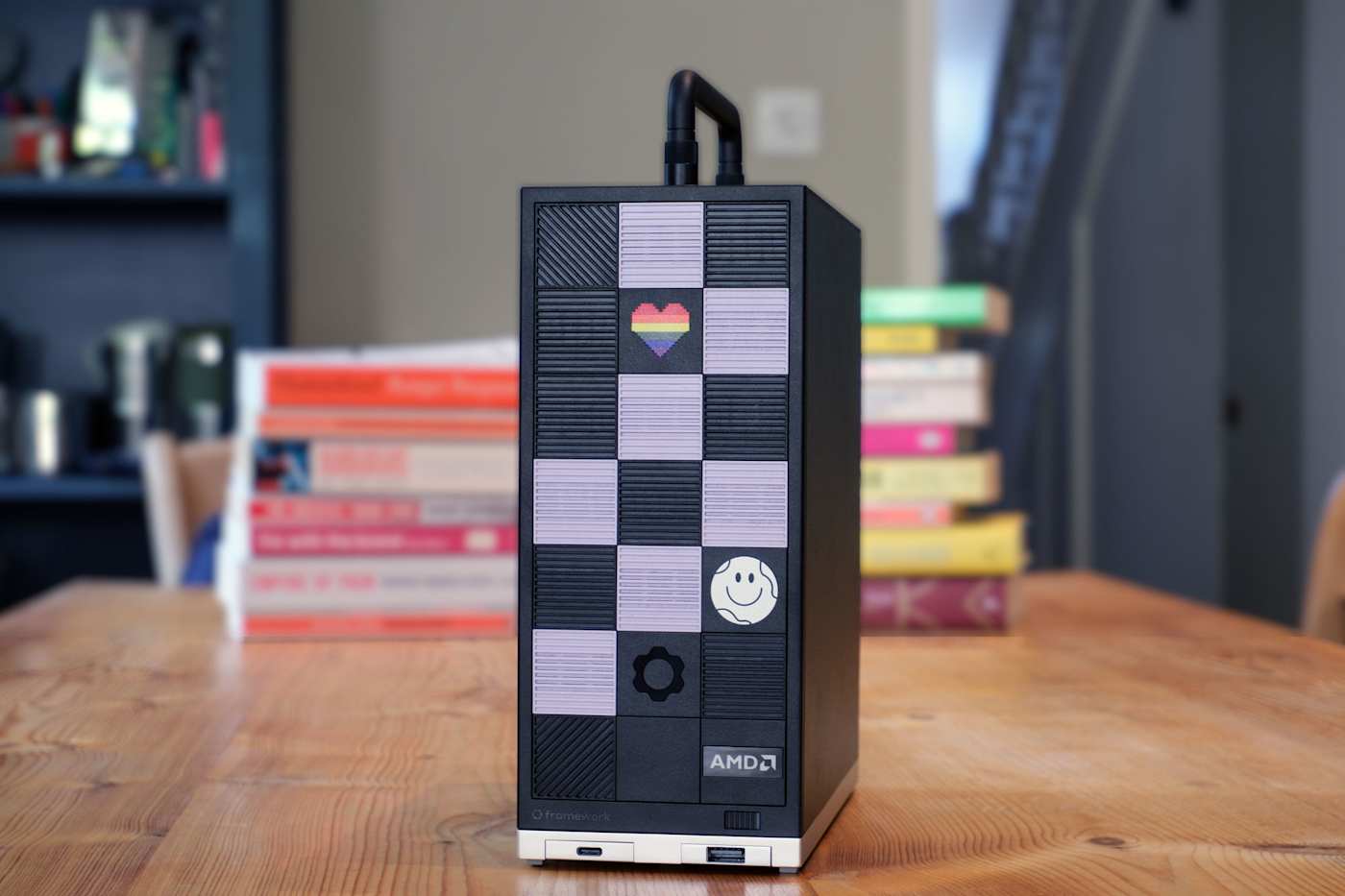Key Points
- Framework Desktop uses AMD Ryzen AI Max APU with up to 128 GB RAM
- Modular for SSD, Wi‑Fi, power supply; APU and cooler are soldered
- Three fixed configurations: 32 GB, 64 GB, or 128 GB RAM
- Assembly is quick – roughly 15 minutes for SSD install and fan attachment
- Integrated Radeon 8060S GPU handles modern games adequately
- AI workloads run efficiently, using about a third of CPU capacity in tests
- Video‑editing tasks complete significantly faster than on lower‑end PCs
- System remains quiet under typical loads; fan audible only during heavy tasks
- Base price starts at $1,099; fully equipped high‑spec model near $2,300
- Best suited for users focused on AI and productivity rather than high‑end gaming


Image of the rear of the Framework Desktop (2025) sat on a wooden table in front of some books. The focus is on its port selection.
Overview of the Framework Desktop
Framework has entered the desktop market with a Mini‑ITX machine built around AMD’s Ryzen AI Max APU. The product combines a CPU, GPU and neural‑processing unit in a single package, promising workstation‑level memory bandwidth and the ability to install up to 128 GB of RAM. The case is a 4.5‑liter black enclosure with a customizable front panel that accepts interchangeable plastic tiles for personalization.
Design and Modularity
The Desktop follows Framework’s modular philosophy for many parts: the Wi‑Fi module, SSD (two M.2 slots are provided), power supply and case can be removed and replaced. However, the APU and its cooling solution are soldered to the mainboard, meaning that a failure of the processor or a need for a different configuration would require replacing the entire board. Replacement mainboards are priced between $799 and $1,699.
Configuration Options
Three fixed configurations are offered, each pairing a different Ryzen AI Max variant with a set amount of RAM and a Radeon 8060S GPU. The options are:
- Ryzen AI Max 385 with 32 GB RAM
- Ryzen AI Max + 395 with 64 GB RAM
- Ryzen AI Max + 395 with 128 GB RAM
All configurations share the same case, power supply and Wi‑Fi module.
Assembly Experience
The Desktop is sold as a DIY edition, but the assembly process is minimal. The chassis arrives with the mainboard, heatsink and fan pre‑installed. The builder only needs to install an SSD, attach the 120 mm fan to the heatsink, close the cowl and secure four screws. Framework’s step‑by‑step guides estimate 30‑45 minutes for the task; the reviewer completed it in about 15 minutes.
Performance in Real‑World Tasks
In gaming, the integrated Radeon 8060S GPU performed well in titles such as Fortnite and Hardspace: Shipbreaker, matching or exceeding expectations for an integrated solution. However, the reviewer notes that the machine is not positioned as a primary gaming PC, especially for users who prefer discrete graphics cards.
For AI workloads, the APU handled a 27‑billion‑parameter model in LM Studio, using roughly a third of the CPU’s capacity, indicating headroom for larger models. Video‑editing benchmarks showed a 2‑hour, 39‑GB source file being trimmed, compressed and exported to a 6‑GB MP4 in just over an hour, a substantial speed increase over less powerful hardware.
Acoustic and Thermal Characteristics
Framework claims the Desktop remains quiet under normal and gaming loads. In practice, the 120 mm fan is barely audible during routine use and only becomes noticeable when running heavier AI models or during long video‑export sessions. The system does not overheat, despite the APU’s 120‑W base power and potential 140‑W boost.
Pricing and Value Proposition
The base model with the Max 385 and 32 GB RAM starts at $1,099, covering the case, power supply, mainboard and Wi‑Fi module. Optional items such as SSD, fan, operating system and power lead are priced separately, raising the total for a ready‑to‑use system to roughly $1,386. Upgrading to the 64‑GB or 128‑GB configurations adds $500 or $900 respectively, bringing the fully equipped price to about $2,286.
Comparatively, a $2,200 pre‑built workstation from other vendors can provide a Ryzen 7 CPU, 16 GB DDR5, a 1‑TB SSD and a discrete RTX 4070 Ti or Radeon RX 9070 XT. The Framework Desktop’s differentiator is the AI‑optimized memory bandwidth of the Ryzen AI Max, which may justify the premium for users focused on AI and heavy‑compute tasks.
Conclusion
The Framework Desktop delivers strong performance for AI, video‑editing and moderate gaming workloads while maintaining a degree of modularity uncommon in many pre‑built PCs. Its trade‑off is the limited repairability of the core APU and the reliance on an integrated GPU, which may deter traditional gamers or users seeking full component interchangeability. For a niche audience that values the AI‑centric capabilities and appreciates a compact, customizable chassis, the Desktop presents a compelling, albeit premium, option.
Source: engadget.com
